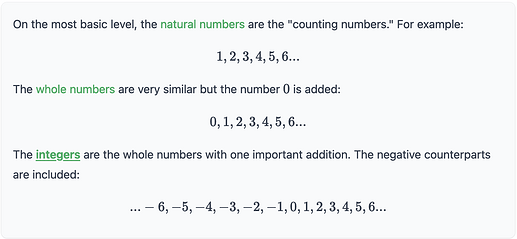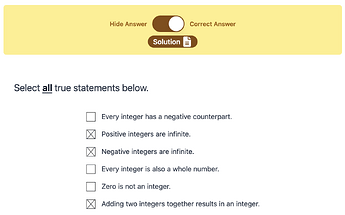Hi!
Just completed the first day for PrepSwift Quant. I’m enjoying it so far, it’s good practice! But I have a question about the definitions used in the Integers video:
The definitions of “whole”, “natural”, and “counting” numbers are considered ambiguous (source: math background). For example, Wikipedia has this discussion:
In mathematics, the natural numbers are the numbers 0, 1, 2, 3, and so on, possibly excluding 0. Some start counting with 0, defining the natural numbers as the non-negative integers 0, 1, 2, 3, …, while others start with 1, defining them as the positive integers 1, 2, 3, … . Some authors acknowledge both definitions whenever convenient. Sometimes, the whole numbers are the natural numbers plus zero. In other cases, the whole numbers refer to all of the integers, including negative integers. The counting numbers are another term for the natural numbers, particularly in primary school education, and are ambiguous as well although typically start at 1.
I’m looking for clarification: are the definitions in the screenshot the ones used by ETS? They weren’t covered by ETS’s math conventions.
If they are, I’d like to make sure I memorize their convention. But if not I’ll just move on.
You can move on. I am not 100% sure what ETS uses, but yes there’s a degree of ambiguity here. The most important definition is the one about integer itself.
1 Like
Thanks! Will do.
I did end up missing a question because of this:
Every integer is also a whole number.
The solution is “false” but that depends on the definition of “whole number”, one of which is a synonym for the integers. But I think I’ll just chalk that up to an ambiguous question.
No, because no matter how you interpret “whole numbers” reasonably, the answer does not change.
Sorry but no. Re-quoting Wikipedia (emphasis mine):
In other cases, the whole numbers refer to all of the integers, including negative integers.
In that sense, the “whole” numbers are those with no fractional part. It’s a quite “reasonable” interpretation.
When referring to whole numbers, I have usually seen that they don’t include the negative integers. Regardless, it’s a moot point. ETS is not going to test “whole numbers” anyway. They will use the word “integer.” If they’re referring to only the positive integers, they’ll say “positive integers.”
1 Like
Hey thanks for weighing in! Totally agree it’s a moot point.
My main goal was to check if ETS has specific definitions of “whole” and “natural” I needed to know. That is definitely not the case.
Lol, the reference in the wiki snippet you linked isn’t even from a math text, but I agree with you nonetheless.
Since “numbers” is/are a vague term, they usually refer to “real numbers” and thus “whole numbers” are the real numbers with no fractional part, i.e. they would be the integers. However, more elementary sources often treat “whole numbers” and “natural numbers” as synonymous.
1 Like

